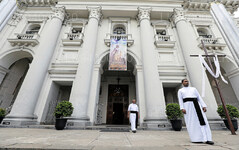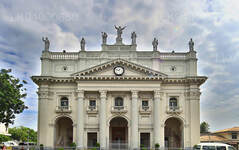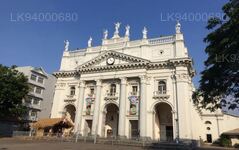
Miasto Kolombo
Kolombo, stolica Sri Lanki, to dynamiczne miasto łączące tradycję z nowoczesnością. Zachwyca kolonialną architekturą, tętniącymi życiem targowiskami i spokojnymi świątyniami buddyjskimi. Z różnorodną kuchnią, rozległą panoramą i pięknymi plażami, stanowi tętniące życiem centrum biznesu, kultury i turystyki, oferując bramę do odkrywania cudów Sri Lanki.
St Lucias Catherdral
St. Lucy of Sicily whose feast falls on December 13 is venerated the world over as the protectress against eye trouble. Legend has it that she had the most beautiful pair of eyes and that she pulled them out to present them to an unwelcome suitor who was enamored by their beauty. However, her eyes were miraculously restored to her more beautiful than before. Named after this virgin and martyr saint are St. Lucia’s Cathedral of Kotahena, the oldest and largest parish cathedral in Sri Lanka and the seat of the Archbishop of Colombo.
The 110-year-old cathedral had humble origins in a small chapel of wood and Cadjan built by the Oratorian fathers in 1760 when Ceylon was under Dutch occupation. This was replaced by a larger church of brick and mortar in 1782. When Ceylon was detached from the jurisdiction of the Archbishop of Goa in 1834, Rev. Fr. Vincenti Rosario was appointed the first Vicar-Apostolic of Ceylon and St. Lucia’s Cathedral became the first cathedral of Sri Lanka. Eventually, the foundation stone for a new cathedral building was laid to replace the old one. In 1873 Bishop H D Sillani and Rev. Fr. S Tabarrani, men of great vision and talent designed and initiated the building of St. Lucia’s Cathedral thus planting the seeds of grandeur and Lnagnificence of what was to be.
The Catholics of Colombo, the churches outside the city, and even the fisher folk contributed their share to the building fund. The cathedral cost Rs 160,000 to build which was an enormous amount in the last century, yet totally funded by the pious generosity of the Ceylonese Catholics of the time. Towards the end of 1887 the main body of the cathedral was completed and the blessing of the cathedral took place in December of that year. However the building of the cathedral took 30 years and was completed in 1902 when the scaffoldings were finally dismantled and the site cleared. The succeeding generations of parishioners and parish priests continued to embellish the cathedral with exquisite statues and sacred vessels often shipped from Europe. After a succession of European priests Rev. Fr. Nereus Fernando became the first Sri Lankan parish priest of the cathedral in 1956. Under the dynamic leadership of Rev. Fr. Rufus Benedict the cathedral was prepared for its centenary which was celebrated in December 1987. St. Lucia’s Cathedral Kotahena is the legacy of parishioners whose fervent faith aspired to build this magnanimous tribute to God. At the threshold of yet another century the cathedral stands unsurpassed in beauty and in magnificence as it has always stood over the last one hundred years.
O dystrykcie Kolombo
Kolombo to największe miasto i stolica handlowa Sri Lanki. Położone jest na zachodnim wybrzeżu wyspy, w sąsiedztwie Sri Jayewardenepura Kotte, stolicy Sri Lanki. Kolombo to tętniące życiem i pełne życia miasto, łączące w sobie nowoczesny styl życia z kolonialnymi budynkami i ruinami. Liczba mieszkańców wynosi 647 100. Region Metropolitalny Kolombo, definiowany przez dystrykty Kolombo, Gampaha i Kalutara, liczy około 5 648 000 mieszkańców i zajmuje powierzchnię 3694,20 km². Kolombo to miasto wieloetniczne i wielokulturowe. Jest to najludniejsze miasto na Sri Lance, z 642 163 mieszkańcami mieszkającymi w granicach miasta. Populacja Kolombo to mieszanka licznych grup etnicznych, głównie Syngalezów, Maurów i Tamilów. W mieście mieszkają również niewielkie społeczności osób pochodzenia chińskiego, portugalskiego, holenderskiego, malajskiego i indyjskiego, a także liczni europejscy emigranci. Zdecydowana większość lankijskich korporacji ma swoje siedziby w Kolombo. Wśród branż znajdują się m.in. przemysł chemiczny, tekstylny, szklarski, cementowy, skórzany, meblarski i jubilerski. W centrum miasta znajduje się drugi co do wysokości budynek w Azji Południowej – World Trade Center.
O dystrykcie Kolombo
Prowincja Zachodnia jest najgęściej zaludnioną prowincją Sri Lanki. Znajduje się tu stolica parlamentarna Sri Dźajawardanapura Kotte, a także Kolombo, centrum administracyjne i biznesowe kraju. Prowincja Zachodnia dzieli się na trzy główne dystrykty: Kolombo (642 km²), Gampaha (1386,6 km²) i Kalutara (1606 km²). Jako centrum gospodarcze Sri Lanki, w mieście obecne są wszystkie główne lokalne i międzynarodowe korporacje, a także wszyscy najwięksi projektanci i detaliści, dlatego warto przygotować się na zakupy w prowincji Zachodniej. Z uwagi na największą liczbę ludności w całej prowincji, w prowincji Zachodniej znajdują się niemal wszystkie najważniejsze instytucje edukacyjne na wyspie. Do uniwersytetów w prowincji zaliczają się: Uniwersytet Kolombo, Uniwersytet Sri Jayewardenepura, Uniwersytet Kelaniya, Otwarty Uniwersytet Sri Lanki, Uniwersytet Buddyjski i Palijski Sri Lanki, Uniwersytet Obrony Generała Sir Johna Kotelawali i Uniwersytet Moratuwa. W prowincji zachodniej znajduje się najwięcej szkół w kraju, w tym szkoły państwowe, prowincjonalne, prywatne i międzynarodowe.







































